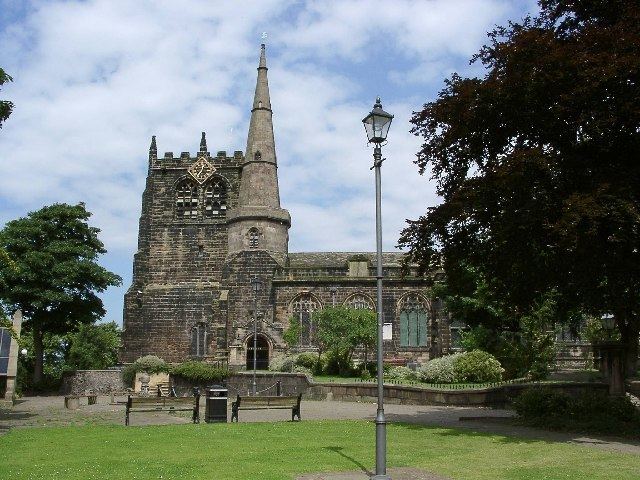OS grid reference SD 4130608436 Country England Functional status Active Phone +44 1695 572143 | Denomination Anglican Heritage designation Grade II* | |
 | ||
Address New Church House, Church St, Ormskirk L39 3AJ, UK Similar St Paul's Church - Skelmersdale, St Michael and All Angels C, St Michael's Church - A, St Cuthbert's Church, St James the Great Church | ||
The Church of St Peter and St Paul is in the market town of Ormskirk, Lancashire, England. Dating from no later than the 12th century, it is one of only three churches in England to have both a western tower and a central spire, and the only one to have them both at the same end of the church. It is an active Anglican parish church in the Diocese of Liverpool. The church is recorded in the National Heritage List for England as a designated Grade II* listed building.
Contents
History
The exact date of the foundation of a church in Ormskirk is unclear, although it is likely that there was a church on the site of the present one in Saxon time. The Anglican parish of Ormskirk encompassed the settlements of Lathom, Burscough, Bickerstaffe, Scarisbrick and Skelmersdale. Parts of the present church existed in the 12th century, although the building has been altered and added to over successive centuries. The north wall of the chancel dates from c. 1170. A chapel was added to the south c. 1280. The steeple was added in the late 14th century. The large west tower was built c. 1540–50. The tower was probably built to house the bells from Burscough Priory, which had been suppressed c. 1536 as part of Henry VIII's Dissolution of the Monasteries. This is one of only three churches in England to have both a western tower and a central spire. Between 1877 and 1891 the Lancaster architects Paley and Austin and their successors carried out restoration work in the church. These included reflooring and reseating the church, installing a new heating system, removing the galleries, and rebuilding and reroofing parts of the church.
Exterior
The church is situated on a raised piece of land in the north-west of the town. Mostly in the Perpendicular Gothic style, it is constructed of coursed squared sandstone, with stone slate roofs. It has a nave, with aisles to the north and south. The large square tower is to the west, approximately 84 feet (26 m) high and 40 feet (12 m) square; it has three unequal stages and diagonal buttresses. The upper-most stage has a crenellated parapet and crocketed pinnacles. The tower has arched three-light belfry windows with tracery and stone louvres.
The steeple sits on the south-east corner of the tower (also at the west end of the nave), approximately 25 feet (7.6 m) higher than the tower. The steeple is square, with an octagonal bell stage. The bell louvres are Decorated Gothic. To the north of the building is the chancel and vestry. The Scarisbrick Chapel is to the south, and the Derby Chapel to the south-east.
In his Passages from the English Notebooks of 1876, Nathaniel Hawthorne commented that the church "has not exactly a venerable aspect, being too good in repair, and much restored in various parts".
Interior and fittings
The nave's ceiling is of wood and has carved hammerbeam trusses. The five-bay aisle arcades have moulded piers and two-centred arches. Between the steeple and the south aisle there is a chamfered arch. The vestry has in its western wall, an unglazed window that opens into the north aisle. It has a square head and original iron stanchions and saddle bars.
The Derby Chapel is enclosed to the north and west by a 17th-century wooden screen with high balusters and wrought iron fleur-de-lis cresting. The chapel also contains three alabaster Derby effigies (probably to Thomas Stanley, 1st Earl of Derby and his two wives) and two tomb chests. The Scarisbrick Chapel contains a hatchment and a wall monument. James Stanley, 7th Earl of Derby is also buried at the church.
The church has a ring of eight bells hung for change ringing, all cast in 1948 by John Taylor & Co of Loughborough. It also houses a bell cast in 1576 by Henry Oldfield of Nottingham, but this is no longer in use.
